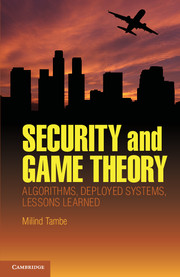Book contents
- Frontmatter
- Contents
- Acknowledgments
- 1 Introduction and Overview of Security Games
- PART I SECURITY EXPERTS' PERSPECTIVES
- 2 LAX – Terror Target: The History, the Reason, the Countermeasure
- 3 Maritime Transportation System Security and the Use of Game Theory: A Perfect Match to Address Operational and Tactical Concerns
- PART II DEPLOYED APPLICATIONS
- PART III EFFICIENT ALGORITHMS FOR MASSIVE SECURITY GAMES
- PART IV FUTURE RESEARCH
- PART V SHORT BIOS
- References
- Index
2 - LAX – Terror Target: The History, the Reason, the Countermeasure
from PART I - SECURITY EXPERTS' PERSPECTIVES
Published online by Cambridge University Press: 05 January 2012
- Frontmatter
- Contents
- Acknowledgments
- 1 Introduction and Overview of Security Games
- PART I SECURITY EXPERTS' PERSPECTIVES
- 2 LAX – Terror Target: The History, the Reason, the Countermeasure
- 3 Maritime Transportation System Security and the Use of Game Theory: A Perfect Match to Address Operational and Tactical Concerns
- PART II DEPLOYED APPLICATIONS
- PART III EFFICIENT ALGORITHMS FOR MASSIVE SECURITY GAMES
- PART IV FUTURE RESEARCH
- PART V SHORT BIOS
- References
- Index
Summary
Introduction
The history of plots and attacks on LAX suggests that it has achieved a level of importance in the minds of a diverse collection of terrorist organizations. The counterterrorism community is challenged by an intelligent and adaptive adversary who is prone to return to targets and continues to demonstrate sustained intent and an evolving attack methodology. LAX seems to present itself as an elusive trophy, as homeland security forces struggle, along with the rest of the world, to achieve and maintain a level of resistance capable of thwarting a man-enabled catastrophe.
“Over 5,000 deaths have resulted from terrorist attacks on civil aviation since 1980; about 200 deaths occurred in attacks on airports themselves, as opposed to aircraft.” Although the aviation domain has become the hardest critical infrastructure since the terror attack on September 11, 2001, it remains the most desirable for the attacker. There are essentially three fundamental strategies for attacking the aviation system – hijackings, bombings, and airport assaults. Security countermeasures designed to reduce the threat of in-flight incidents suggest attacks on airport facilities are probable.
A Brief History of Significant Events
Terrorism has long been a serious threat to the air transportation system of the United States and other nations. In 1972, three members of the Japanese Red Army initiated what is now known as the Lod Airport Massacre.
- Type
- Chapter
- Information
- Security and Game TheoryAlgorithms, Deployed Systems, Lessons Learned, pp. 27 - 50Publisher: Cambridge University PressPrint publication year: 2011
- 1
- Cited by



